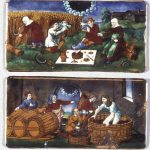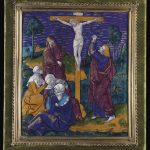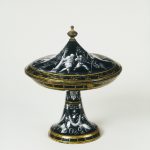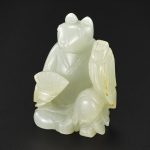Pénicaud Family. The Penicaud were French enamelers active in Limoges during the 16th century. They were considered to be among the finest such craftsmen of their time. They were noted for their work in grisaille enamel, monochromatically painted enamel work intended to look like sculpture. Nardon Pénicaud (c. 1470–c. 1542), the first recorded member of the family, worked in the French Gothic style, but his brother or son, Jean I (fl. 1510–40), introduced motifs characteristic of the Italian Renaissance. Jean I was also the first enameler to frequently apply transparent enamel colours on copper. The existence of two other members of the Pénicaud family also named Jean is disputed, although Jean II has been often cited as an important master of the grisaille technique. The last prominent enamelist of the family, Pierre, is considered a mediocre artist. Reference: Wikipedia
Much of the Penicaud Family’s work was of a religious nature, however some Limoges plaques had astrological themes. Below are some examples of work by the Penicaud Family and includes themes other than astrological.
A Limoges enamel plaque of the Adoration of the Magi attributed to the workshop of Leonard Nardon Pénicaud (1474?-1539?) 16th century sight 3 1/2 x 6in (9 x 15cm); framed 5 1/2 x 8 1/4in (14 x 21cm)
Sold for US$ 2,375 (£ 1,785) inc. premium at Bonhams in 2015
Painted Limoges enamel plaque; copper, rectangular; The Labour of the Month of August; harvesters relaxing and eating while one woman continues to cut corn; house, napkin with bread and cheese; zodiacal sign of Virgo in the sky; painting in semi-opaque enamels and translucent enamels over coloured foils, gold and red; zodiac sign in gilding; counter enamel translucent, stamped with Penicaut stamp.
Workshop of: Jean Pénicaud II Date 1555 (circa)
Reference: © The Trustees of the British Museum
RECTANGULAR PLATE IN POLYCHROME PAINTED ENAMEL WITH GOLDEN REHAUTS REPRESENTING THE CRUCIFIXION ENTOURAGE OF JEAN I PENICAUD, CIRCA 1525-1540 Christ on the cross in the center, flanked by the Evangelist John, the Virgin Mary, Mary Magdalene, Salome and Mary Cleophas; in a naturalistic landscape, the sky and the flowers richly gilded; in a posterior period in vermeil and on a rectangular background trimmed with green velvet; very slight wear on the gilding 18.5 x 16.3 cm. (7¼ x 6½ in.); Total height: 23.3 cm. (9¼ in.)
Sold for EUR 121,000 at Christies in 2009
Triptych with: Pilate Washing His Hands, Christ Carrying the Cross, The Crucifixion, Harrowing of Hell and The Appearance of Christ to His Mother French (Limoges) early 1530s Atelier of Jean Pénicaud I (French, about 1480–after 1541)
On central plaque crucified Christ with ornate halo on fan-shaped cross. On left wing Pilate above and below, Christ carrying the cross. On right wing, robed Christ with staff at Hell’s entrance above and below, Christ with virgin at prayer desk.
Reference: Museum of Fine Arts Boston
Jean Pénicaud III, 1520 – 1620, Limoges, 16th century Saint Catherine of Alexandria FRENCH, LIMOGES, 16TH CENTURY PAINTED ENAMEL PAX WITH STE CATHERINE OF ALEXANDRIA, BY JEAN PENICAUD III, MONOGRAMMED; IN A GILT BRONZE FRAME monogrammed IP kiss of peace enamel painted; in a gilded bronze frame, on a velvet display rack 10 x 6.5 cm; 4 x 2 2/3 in.
Sold for 1,500 EUR at Sothebys in 2015
A wide shallow covered footed copper dish painted in grisaille enamels with flesh tones and gilding on a dark ground, depicting scenes from the life of Samson from the Book of Judges. The inside of the tazza depicts Delilah shearing Samson’s hair and his capture by the Philistines, while the underside is painted with emblems of the Passion (crown of thorns, nails, lance). The scenes on the cover and emblems of the Passion indicate that Samson’s trials prefigured those of Christ. The cover depicts Samson, the fox and grain, a reference to Samson burning the fields of the Philistines; Samson slaying the lion; Samson carrying the gates of Gaza, and Samson tearing down the pillars of the temple. The underside of the cover is painted in gold ‘en camaieu’ with the marriage feast of Samson, and Samson slaying the Philistines with the jawbone of an ass.
This tazza and cover has been in several well-known collections. It was owned by the writer and collector Horace Walpole (1717-97) and displayed at Strawberry Hill, his house in Twickenham. After the sale of his collection in 1842, it was bought by William Beckford (1760-1844) and by descent, entered the collection of the Dukes of Hamilton. This piece is decorated with scenes from the life of Samson as described in the Book of Judges in the Bible. The use of the Samson story on Limoges painted enamels is relatively rare and this example is particularly finely painted by Jean Pénicaud II (active 1534-49). Probably one of the sons of the enameller Nardon Pénicaud and nephew to Jean Pénicaud I, Jean Pénicaud II was the leading exponent in Limoges of a Renaissance style based on the Italian Mannerism of the Fontainebleau School. He excelled in both grisaille and polychrome painted enamels, though he showed a preference for grisaille work and his extant polychrome works are rare. He created both ecclesiastical and secular work and is especially known for his reliquaries and portraits such as the medallion of Pope Clement VII (Paris, Louvre inv.OA 1000). His signed and dated works are few but his style is recognisable especially in his fine representation of faces and use of subtle flesh tones. This tazza can be firmly attributed to Jean II Penicaud even though the inscription on the foot bearing his name and the date is probably part of a nineteenth-century restoration.
Reference: © Victoria and Albert Museum








